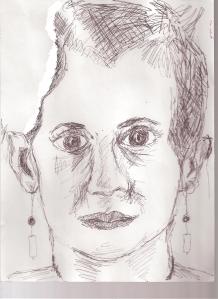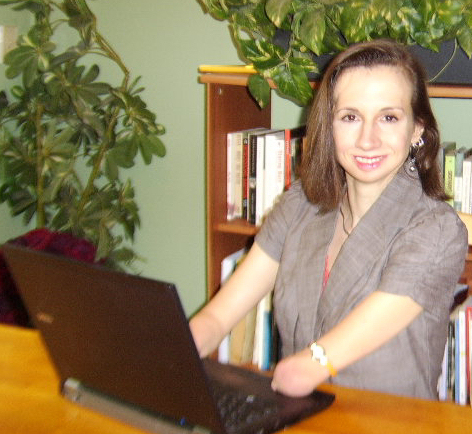 I began teaching for the BLS Program in Spring 2007. I taught my “Photography: Contexts and Illusions” class and was developing another BLS course, “The Art of Life,” as well as an Introduction to Art class. I was supposed to begin teaching full time the next Fall, but life interfered. While traveling with a friend in San Francisco in May, I had an accident and suffered from traumatic brain injury. I did teach Photography again Fall of 2007, but it would be another year before I could resume all my teaching.
I began teaching for the BLS Program in Spring 2007. I taught my “Photography: Contexts and Illusions” class and was developing another BLS course, “The Art of Life,” as well as an Introduction to Art class. I was supposed to begin teaching full time the next Fall, but life interfered. While traveling with a friend in San Francisco in May, I had an accident and suffered from traumatic brain injury. I did teach Photography again Fall of 2007, but it would be another year before I could resume all my teaching.
Bob Hansen was kind enough to cover my “Art of Life” course for me until the Fall of 2008. When I first began teaching it, it was all new to me, because my accident had caused significant memory loss. I did not recall how the class was conceived or why I chose the specific examples and readings for it. However, I felt an eerie sense of fate or destiny teaching a course based on the idea that art emerges from everyday life, and that specifically art may be considered, ultimately, as an accident. Much of the subject matter of the course surrounds how accidents can lead to insight and inspiration, and I began teaching it while I was still struggling with the physical and psychological effects of my accident. One of the writing assignments my students had to complete was an essay on the theme of loss and discovery, which resonated with a lot of what I was going through – dealing with my own losses (of identity, memory, time, etc.), as well as discovering new aspects of myself. I felt inspired to write a response to my own assignment about my accident and its effects on my life, both its consequential losses as well as its discoveries. This is the essay I now post each semester that I teach the course:
For most of 2007, my existence may best be characterized as lost. I had lost weight, lost hair, lost part of my skull, lost much muscular movement and fluidity, and lost my mobility. I had lost my memory, my history, my sense of security, and my identity. I had lost my mind.
Backing up…In May of 2007, I was vacationing in San Francisco with my friend, Anna. We were exiting a café and for some unknown reason, I shot ahead on my travel scooter and fell off the high curb of the sidewalk into the street. According to Anna, I was not drunk, sick, excessively tired, or otherwise impaired before this. It was unexplainable. I hit my head, began to bleed, and an ambulance was called.
This was all told to me later, as I have no recollection of the accident, any of the trip, or even planning it. I have blocked the whole experience out. I have blocked a lot of experiences out. Even as my memory congeals, much of my life takes place in stories and photographs, but not in the sensations of being there. I don’t have any flashes of being in the San Francisco hospital for 6 weeks, much of the time in a coma, and I recall very little of my time spent in a rehab hospital in Columbus, OH (where I grew up and my family lives). I only remember grueling therapy sessions there and one kind nurse, who let me have the whole container of chocolate pudding that was used to help me swallow medications. I moved in with my mother at the end of the summer, in a place she had rented, but that I thought was her home I didn’t remember. Slowly, my strength and endurance came back. I exercised, read, wrote in a journal, and began to re-member – to put mind and body back together. Yet, I was content to rarely leave my sanctuary.
In a couple months, I had surgery on my skull to reconstruct the amputation, after which, I had been told, I would improve drastically. Unfortunately, I had to endure a week in the hospital before I had the surgery, after an anesthesiologist punctured my lungs trying to put an IV in my chest. But I digress. I did feel better after my skull was intact, and in just a few weeks, I began teaching an online class, one of which I was supposed to be teaching full time that Fall. My knowledge of art history, the humanities, and how to teach came right back and, likely, got stronger. I was able to concentrate and exert authority, more and more over time. I soon moved back to my home in North Carolina and to my boyfriend, whose name I could now remember. As 2008 progressed, so did I, and I was determined to no longer put anything off. I proposed to the man I love and got married, taught full time, and began to write scholarly articles and to paint again. But I was still lost.
Backing up further…I have been physically disabled since birth, and I have incorporated disability studies as a discipline, as well as my identity as a disabled woman, into my teaching and writing. I know how to teach myself to do things and how to adapt to do anything I want to do. I am (was?) independent. I have traveled internationally, lived in 3 cities, and gotten my PhD. I was, for better or worse, fearless. Now I feel anxious taking my scooter to the grocery store. But the anxiety about injury lessens over time. The anxiety over being lost is still, and may always be, unbearable. I can’t sleep through the night, my moods oscillate from high to low without warning, and I can’t remember people, places, and personal things. I sometimes have to laugh, as, for example, I realize that not everyone looks oddly familiar because I have forgotten them, but that people just look alike. I can laugh at my loss, at times, while at other times I am consumed by feelings of emptiness and the desire to know what happened, and why.
I have learned many, countless things from my accident, about myself and the world I live in. But the main thing I have learned is that “lost” and “found” are not absolutes. They are states of being, always in flux. They collide, overlap, and intertwine. Sometimes, they make it a chore to get up in the morning. And sometimes, they produce accidental masterpieces.
The responses of the students to my essay were ones of admiration, respect, and identification. Many shared with me similar experiences of their own or of others they knew. I believe students also felt more open with me and shared more of themselves with me and with fellow students in their writing. They also encouraged me to write more. I did. Over the next few years, I drafted four more essays or chapters about my experiences in hospitals and with multiple channels of recovery, including physical, craniosacral, and art therapies. Eventually, I had a book – a memoir that incorporated research as well as personal narrative. The structure and range of subjects in the book, I felt, echoed how my brain works; in it, I switch between various subjects of interest to me and forms of writing, I go off on tangents, and often I compose text from fragments of information and memory.
Once I felt the book was nearly completed, I submitted proposals to publishers and got many respectful and complimentary rejections, as I was repeatedly told that they simply did not publish memoirs. I wanted to see my work assembled and distributed, to complete the project so that I could share my story with others, and to perhaps provide them with hope. I chose to self-publish with CreateSpace through Amazon.com.
Here is a link to its listing.
I did all the formatting of the manuscript myself, which was, admittedly, a pain; I hired my sister who was a journalist to edit; and I paid a professional to design a cover. I am proud of the project and hope readers of this blog will be interested in it. It really epitomizes the intersections between art and life, as well as the various intersections between life and online education.








